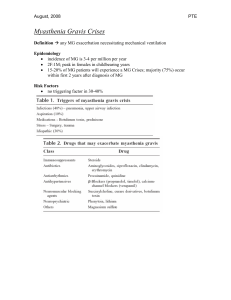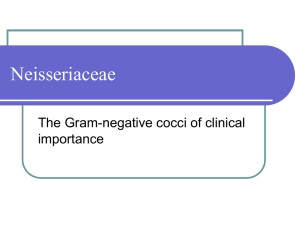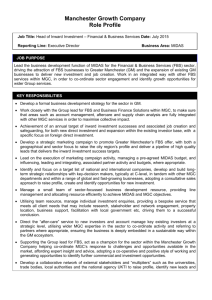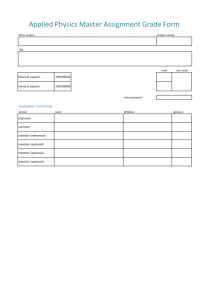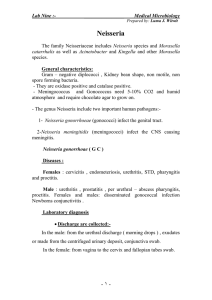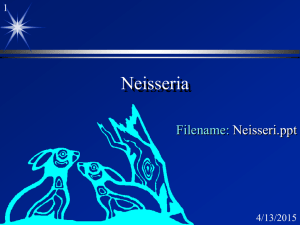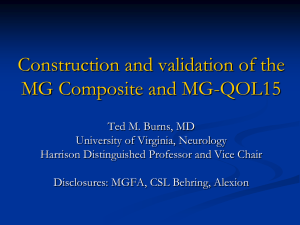04Neisseriaceae2012 - Cal State LA
advertisement
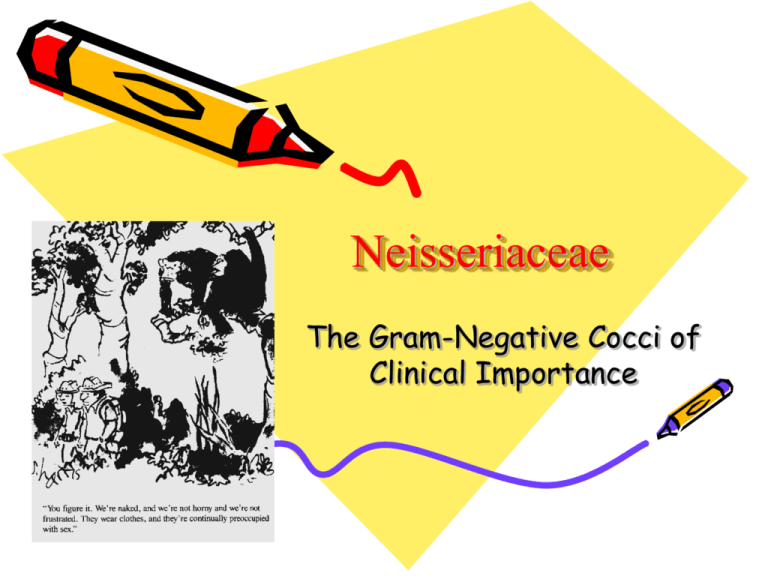
Neisseriaceae The Gram-Negative Cocci of Clinical Importance Neisseriaceae Genera • Gram (-) cocci & rods: – Neisseria – aerobic cocci – Kingella - coccobacilli; fac. anaerobes • Former members: Moraxellaceae – Moraxella (Branhamella) - cocci; asacchrolytic – Acinetobacter - rods Neisseria • Found as NF of naso- and oropharynx – – – – N. lactamica N. sicca N. subflava N. mucosa • Human pathogens - encapsulated – N. gonorrhoeae (GC) – strict pathogen – N. meningitidis (MGC) – NF in 3-30%, pathogen Gram Stain • Gram (-) diplococci, adjacent sides flattened (coffee-bean) • In a direct smear GC found extracellular, intracellularly in PMN Culture Media: TSA • Non-pathogenic Neisseria ssp., M. catarrhalis grow on TSA • Colonies of may be dry, wrinkled, opaque, yellow, tend to be selfadherent Enriched Media: CBA, CHOC • MGC & GC fastidious, require serum or blood • MGC grows on CBA and Chocolate agar • GC grows only on CHOC • Colonies small, translucent to grayish-white Selective Media: MTM • Specimen with heavy NF • Modified Thayer Martin (MTM): CHOC + antibiotics – – – – Vancomycin - inhibits G(+) Colistin - inhibits Gram (-) Nystatin - inhibits fungi Trimethoprim - inhibits swarming Proteus – Occasional strains of GC sensitive to Vancomycin, so both CHOC and MTM always used – May require 48-72 hours for growth Lab Culture: CO2 • Neisseria and Moraxella aerobic, no growth under anaerobic conditions • MGC & GC require CO2 (3-10%) for growth, particularly primary isolation plates Lab Culture: Temperature • GC & MGC sensitive to temperature extremes, drying: – At 25°C produce autolytic enzymes and alkaline pH, lead to cell lysis – Optimal culture – specimen from patient plated directly onto culture media, incubated immediately Neisseria Lab ID • Colony morphology on agar plate: size, shape, texture • Gram stain: G(-) diplococci • Catalase (+) and Oxidase (+): – Oxidase test – agar plate or filter paper add chromogenic reducing reagent to test for cytochrome oxidase Biochemical ID: CHO Utilization • Use CHO oxidatively (not fermentatively) • Cystine-tryptic-agar (CTA) sugars - glucose, maltose, lactose, sucrose • Incubate 24-72 hours; check for acid product • Some fastidious GC grow poorly on CTA • Differential ID of isolates: – GC = (+)glucose only – MGC = (+)glucose & maltose – M. catarrhalis = (-) all four CHO Biochemical ID Test • CarboFerm™Neisseria Kit: rapid test – Chromogenic substrate for specific enzymes – ID MOs by enzyme profile – Isolated colony subcultured overnight and then tested for specific enzymes – Preformed enzymes (heavy inoculation MO used with small volume of CHO (glucose, maltose, lactose, sucrose) – Results read in ≤4 hours • DNAse test: M. catarrhalis = (+) all Neisseria = (-). • Nitrate reduction: M. catarrhalis = (+) GC & MGC = (-) ID: Other Methods • Many kits available for serologic ID: – Agglutination (rapid, inexpensive) – Fluorescent antibody staining (sensitive, specific) • Auxotyping: distinguishes GC by nutritional requirements; strains associated with disseminated disease have multiple requirement for arginine, hypoxanthine and uracil (AHU strains) • Nucleic acid current test of choice – Probe based (chemiluminescent label) – PCR based (DNA amplification) for ID of GC directly from clinical samples – Highly sensitive, specific Pathogenicity: N. gonorrhoeae • Capsule – antiphagocytic • Pili- attach to epithelial cells, also antiphagocytic • Cell wall proteins: – Protein I- porin; inhibit PMN phagocytosis, prevents phagolysosome fusion – Protein II – attachment, invasion – Protein III – elicits Ab that protects surface Ags from host bactericidal Ab lysis Pathogenicity: N. gonorrhoeae • Lipooligosaccharide (LOS) – endotoxin; mediates mucous membrane damage, fever, toxcity • IgA protease – cleaves mucosal Ab • Both pili, protein I, II subject to antigenic variation; evade host immune defense • Diseminated gonococcal infection (DGI) strains, resistant to phagocytosis, serum bactericidal activity; multiply in presence of PMNs • Acquire iron from host - outer membrane proteins; enhanced capacity occurs in DGI strains Clinical Significance: N. gonorrhoeae • Transmitted by direct sexual contact • Formerly, most common reportable disease in U.S. • Increase epidemic in 1960’s: – Social change (sex outside of marriage) – Non-barrier contraception (birth control pill) • Concomitant Chlamydia trachomatis infection common (most reportable disease in U.S. today) • Asymptomatic (AS) infections: – Males = 5% – Females = 50% – Serve as carriers to transmit disease Uncomplicated GC Infections: Males • Incubation 1-4 days • Acute urethritis, profuse purulent discharge, dysuria. • Usually restricted to urethra; symptoms clear in few weeks • Rare complications – prostitis, epididymitis • Oropharyngeal infection mild pharyngitis • Anorectal infection – common in homosexual men Uncomplicated GC Infections: Females • Cervix primary site of infection (endocervical columnar epithelial cells) • Increased vaginal discharge, burning or increase frequency of urination, abdominal pain, menstrual abnormalities • Symptoms clear in few weeks • Infected mothers can transmit GC to babies at birth (ophthalmia neonatorum): – Lead to blindness – Erythromycin eye drops given at birth for prevention Complicated GC Infections • Untreated AS infection may spread to the bloodstream causing disseminated gonococcal infection (DGI) in both men (rare) and women (1-3%) • Infection of skin & joints – fever, arthritis, maculopapular rash Complicated GC Infections: Women • 10-20% present with pelvic inflammatory disease (PID) • Ascending infection, spread • Resulting in: – Endometritis – Salpingitis (fallopian tubes) – Peritonitis • Symptoms: – abdominal pain – abnormal vaginal, cervical discharge – uterine tenderness • Can result in ectopic pregnancy, infertility GC: Treatment and Antimicrobial Susceptibility • Penicillin no longer drug of choice • Resistant strains emerging (do lactamase testing • CDC recommends combination of antibiotics – Ceftriaxone (1 dose) treat GC – Doxycycline (7 days) treat possible C. trachomatis infection • Prevention requires: – Public Health education – Detection by lab testing – Follow-up of sexual contacts Pathogenicity: N. meningitidis • Capsule (polysaccharide) – host antibodies against capsule protective; only certain serotype antigens found during epidemics (used for vaccine) • Pili - binding to specific NP receptors • IgA protease • Ability to acquire iron from human transferrin Pathogenicity: N. meningitidis • Class 1, 2, 3 antigens function as porins (~Protein I of GC) • Class 5 antigens involved in attachment and antigenic variation (~Protein II of GC) • LOS – endotoxin, symptoms of toxemia common in infection Clinical Significance: N. meningitidis • Endemic worldwide • Epidemic in developing countries • Colonizes nasopharynx of healthy people (3-30%); most common in children, young adults, low socioeconomic population • AS carriers primary source of spread • By aerosols - people with prolonged contact; family members, college dorm, military barrack, prison • Transient infection, clearance after Ab develops • Invasion of bloodstream in individuals lacking bactericidal antibodies, or deficient in certain complement components (C5-C8) • May result in: – Septicemia (meningococcemia) – Meningitis – Pneumonia Meningococcemia • • • • • High fever Shaking Chills Muscle pain Petechial rash (hallmark of MGC infections) • Disease may be moderate, chronic or fulminant MGC: WaterhouseFriderichsen Syndrome • Fulminant type of meningococcemia • Characterized by endotoxin, disseminated intravascular coagulation (DIC) • Hemorrhaging in skin, adrenal glands, other internal organs • Rapid death due to acute generalized toxemia and shock Meninges and CSF MGC: Meningitis • ~300 cases/year in U.S. • Abrupt symptoms: – – – – – Fever Headache Stiffness of back and neck Vomiting Petechial rash • Highly fatal without rigorous antimicrobial therapy (<10% fatality with antibiotics) MGC: Treatment and Antimicrobial Susceptibility • Drug of choice is I.V. penicillin • Or chloramphenicol, ceftriaxone • Use rifampin or cefriaxone for prophylaxis of close contacts • Prevention requires: – Public Health education – Vaccination at risk groups MGC Vaccine • Polyvalent polysaccharide capsular antigens for virulent types (A, C, Y, W1). • Administered to children and adults • Given to those at risk groups: – – – – Students Military Travelers to endemic areas Patients with C’ deficiency Clinical Significance: Other Neisseria, Moraxella • Other Neisseria species - rare septicemia and meningitis • M. catarrhalis – NF, opportunistic infections: – Otitis media, maxillary sinusitis in children – Pneumonia and bronchitis in immunocompromised individuals – Occasional meningitis, septicemia, endocarditis Class Assignment • Textbook Reading: Chapter 17 Neisseria Species and Moraxella Catarrhalis • Key Terms • Learning Assessment Questions Case Study: MGC • A 22-year-old female schoolteacher was brought to the emergency room after a 2-day history of headache and fever. • On the day of admission the patient had failed to come to school and could not be reached by telephone. • When notified of this fact, the patient’s mother went to her daughter’s apartment, where she found her daughter in bed, confused and highly agitated. • The patient was rushed to the local hospital, where she was comatose on arrival. Case Study: MGC • Purpuric skin lesions were present on her trunk and arms. • Analysis of her CSF revealed the presence of 380 cells/mm3 (93% polymorphonuclear leukocytes), a protein concentration of 220 mg/dl, and a glucose concentration of 32 mg/dl. • Gram stain of CSF showed many gram-negative diplococci, and the same organisms were isolated from blood and CSF. • The patient died despite prompt initiation of therapy with penicillin. Case Study: MC - Questions • 1. What is the most likely organism responsible for the fulminant disease? What is the most likely source of this organism? • 2. Chemoprophylaxis should be administered to which people? What are the criteria for administering chemoprophylaxis? • 3. What other diseases does this organism cause? • 4. What virulence factors have been associated with other bacterial species in this genus?
